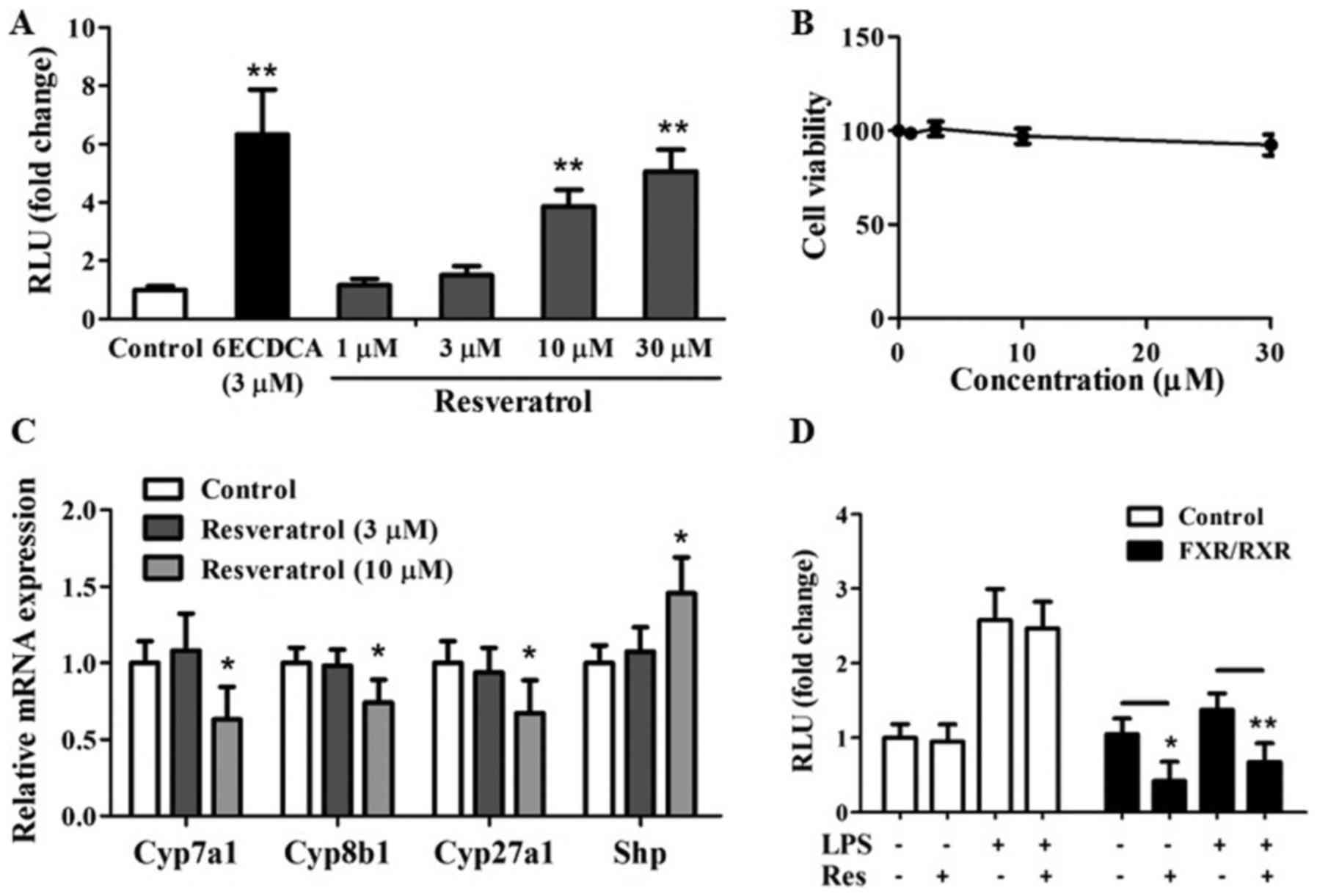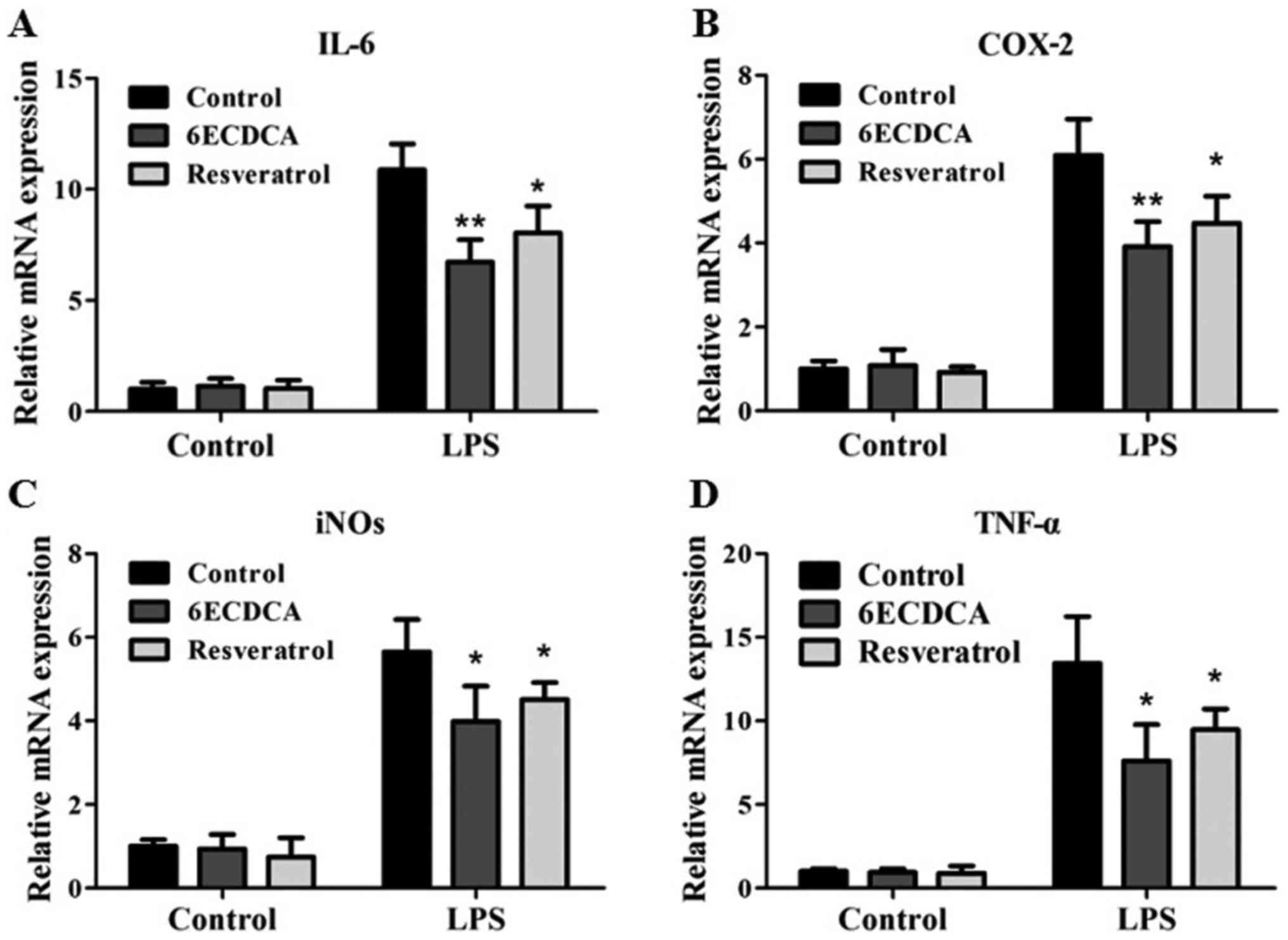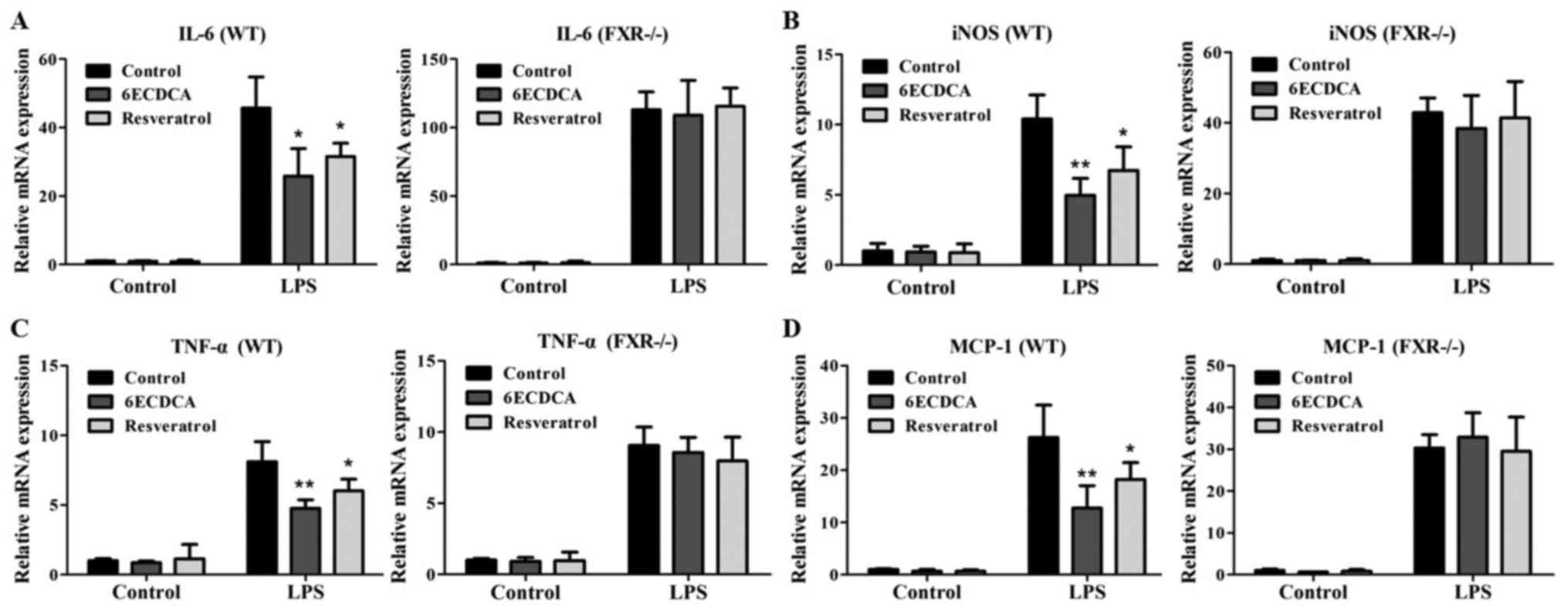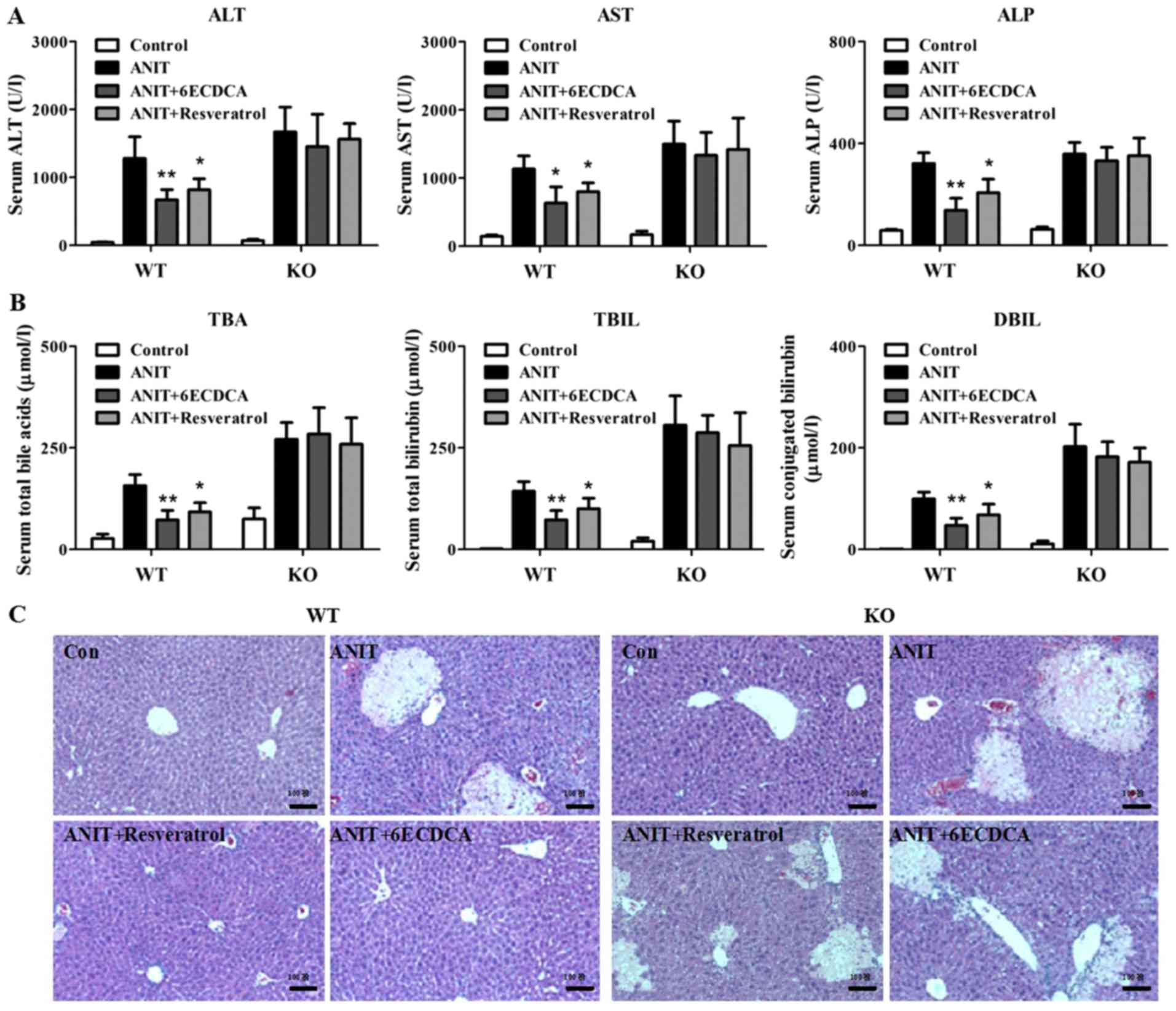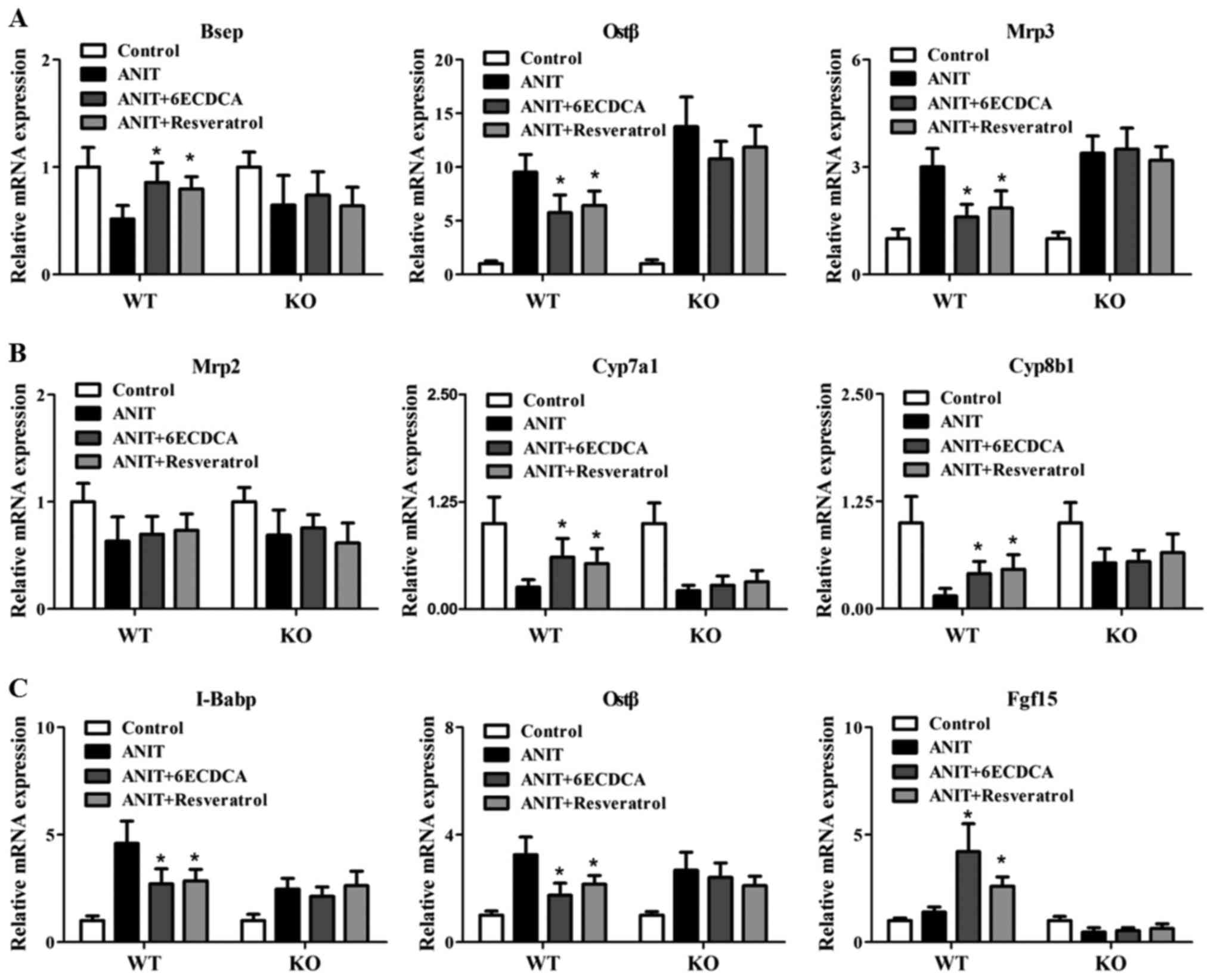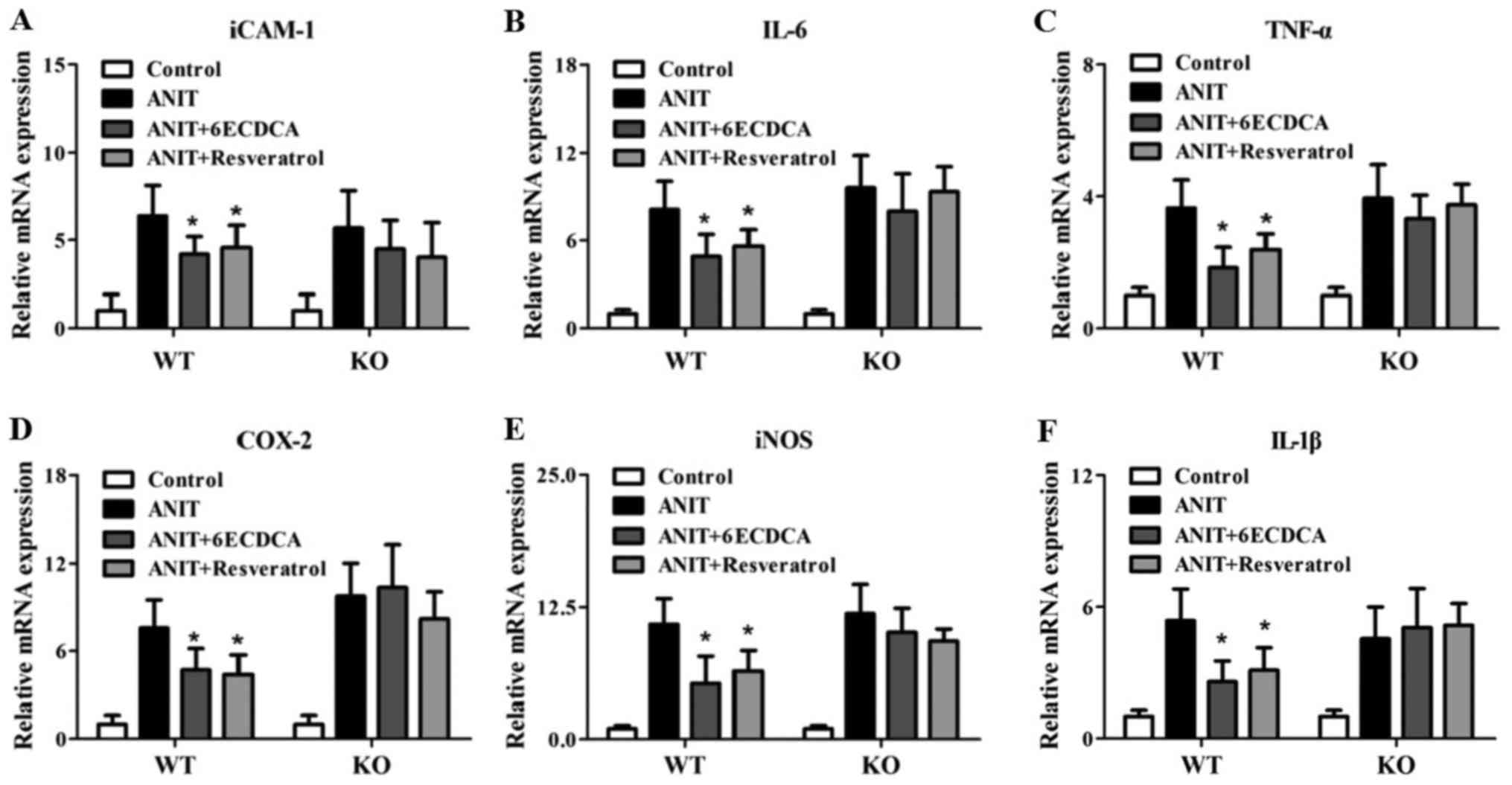Beneficial effect of resveratrol on α‑naphthyl isothiocyanate‑induced cholestasis via regulation of the FXR pathway
- Authors:
- Published online on: November 14, 2017 https://doi.org/10.3892/mmr.2017.8051
- Pages: 1863-1872
Abstract
Introduction
α-Naphthylisothiocyanate (ANIT) as a well known hepatotoxicant is usually administered to experimental animals to mimick the drug-induced cholestasis with liver injury in humans (1). It has been demonstrated that ANIT produced a cholangiolitic hepatitis characterized by intrahepatic cholestasis, hepatocellular and biliary epithelial cell necrosis, and bile duct obstruction (1–4). Cholestasis is always tightly associated with a wide range of diseases including obstructive jaundice (5), acute hepatitis (6), cystic fibrosis (7), primary sclerosing cholangitis (PSC) (8), and primary biliary cirrhosis (PBC) (9). However, up to date, there are very few effective therapies for drug-induced cholestasis except ursodeoxycholic acid which is the only approved drug by Food and Drug Administration (10).
Farnesoid X receptor (FXR) as a nuclear receptor for bile acids (BAs) plays a key role in regulation of BA levels in enterohepatic circulation (11–13). It is expressed in several tissues, including liver, intestine, adipose tissue, the vascular wall, pancreas, and kidney (14). In the liver, BAs bind to FXR, which transcriptionally upregulates an atypical orphan nuclear receptor small heterodimer partner (Shp; NR0B2) to inhibit trans-activation activity of hepatic nuclear factor 4α (HNF4α) and liver receptor homologue-1 (LRH-1; NR5A2) that bind to the BA response element in the cholesterol 7α hydroxylase (Cyp7a1) and sterol 12α-hydroxylase (Cyp8b1) gene promoters (15). In the intestine, BAs binds to FXR to induces the secretion of fibroblast growth factor 15 (Fgf15) (Fgf19 in humans), which activates FGF receptor 4 (FGFR4) and its downstream intracellular signaling pathways on the hepatocytes, such as extracellular signal-regulated kinase (ERK), protein kinase Cz (PKCz), and c-Jun N-terminal kinase (JNK) to repress gene transcription of Cyp7a1 (16,17). FXR as a BA sensor may be an effective strategy to treat cholestasis.
Several natural products activate FXR and are thus the potential therapeutic agents for cholestasis. It has been reported that the natural product, such as Alisol B 23-acetate and geniposidic acid exerted the protective effects of ANIT-induced cholestasis with liver injury through regulation of FXR pathway (18,19). In the present study, we identified that resveratrol, an important ingredient from grape skins and Chinese medicine Polygonum cuspidatum, significantly activated FXR signaling by screening a library of natural products. Then we evaluated whether resveratrol played a role in protection of ANIT-induced cholestasis with liver injury and explored its underlying molecular mechanism. Here, we reported that resveratrol may rescue ANIT-induced cholestasis through the regulation of FXR pathway.
Materials and methods
Reagents and plasmids
6α-Ethylchenodeoxycholic acid (6ECDCA) and lipopolysaccharides (LPS) were both purchased from Sigma-Aldrich; Merck KGaA (Darmstadt, Germany). The HEK293 cell line, phFXR and phRXR expression vectors, FXR dependent reporter (EcRE-Luc), the p65 expression vector, the phRL-TK vector, and the NF-κB dependent reporter plasmid were kindly provided by Dr. Wendong Huang (City of Hope, Duarte, CA, USA).
Transfection and and reporter gene assays
HEK293 cells were grown in Dulbecco's modified Eagle's medium (DMEM) supplemented with 10% FBS were cotransfected with EcRE-Luc, phFXR, phRXR and β-galactosidase at the ratio of 10:2.5:2.5:1 by the Lipofectamine 2000 procedure (Invitrogen Life Technologies, Carlsbad, CA, USA). HepG2 cells were co-transfected with the NF-κB reporter plasmids, or control plasmid phRL-TK, β-galactosidase and FXR/RXR plasmids at 1:1 ratios with the p65 expression plasmid by the Lipofectamine 2000 procedure (Invitrogen Life Technologies). After 24 h, cells were treated with resveratrol (10 µm) or 6ECDCA (3 µm) for 18 h. Then HepG2 cells were treated with/without LPS (2 µg/ml). Following 6 h incubation, cells were harvested and the luciferase activity was determined by using a luciferase reporter assay system in accordance with the manufacturer's instructions (Promega, Madison, WI, USA). The luciferase activity was normalized by β-galactosidase activity. Each transfection was performed in triplicate and repeated at least three times.
Cell viability assay
HEK293 cells were seeded in a 96-well plate at a density of 1×104 cells per well. When confluent, the cells were incubated individually with resveratrol (C14H12O3, MW 228.24, HPLC ≥98%) obtained from Shanghai R&D Center for Standardization of Traditional Chinese Medicine (Shanghai, China) at the concentration of 0.1, 1, 3, 10 and 30 µm, respectively. After incubation for 24 h, 10 µl of CCK-8 solution for each well was used to test the cell viability. The absorbance of the solutions was detected at 450 nm by a microplate reader (Varioskan Flash; Thermo Fisher Scientific, Inc., Waltham, MA, USA). The cell viability rate was calculated as the percentage of CCK-8 absorption as follows: (absorbance of drug – treated sample/absorbance of control sample) × 100%.
Primary mouse hepatocyte culture
Primary hepatocytes from 8-week-old wild-type (WT) and FXR knockout (KO) mice were isolated by two-step perfusion using liver perfusion and liver digest Media (collagenase type I 0.8 mg/ml; Worthington Biochemical Corporation, Lakewood, NJ, USA) as previously described (20). Purity of live hepatocytes was routinely ≥90% by trypan blue exclusion. Hepatocytes were cultured in 10% fetal bovine serum in DMEM supplemented with L-glutamine, antibiotics, insulin-transferrin-selenium, and 4-(2-hydroxyethyl)-1-piperazine ethanesulfonic acid (HEPES) (Mediatech, Manassas, VA, USA). Cells were treated with 6ECDCA (3 µm) and resveratrol (10 µm). Eighteen hours after treatment, the cells were treated with LPS (2 µg/ml), and then collected for RNA isolation after a 6 h incubation.
Animal model and experimental design
WT C57/BL mice were purchased from the Laboratory Animal Center of Shanghai University of Traditional Chinese Medicine. FXR KO mice were transferred from UC Davis Medical Center (Sacramento, CA, USA) and reproduced in SHUTCM animal room. The mice were housed at 20±2°C with relative humidity at 60–70%. The animal welfare strictly complied with the Guide for the Care and Use of Laboratory Animals, and the instructions for the Animal Experiments were approved by the Institutional Animal Committee of Shanghai University of Traditional Chinese Medicine [permit no. SCXK (Hu) 2012–0002]. WT and KO mice were randomly assigned into four groups (control, ANIT, resveratrol+ANIT and 6ECDCA+ANIT), respectively. Resveratrol+ANIT group and 6ECDCA+ANIT group mice were treated with resveratrol (60 mg/kg), or 6ECDCA (20 mg/kg) respectively for 5 days while control and ANIT (Sigma-Aldrich) group mice were given normal saline. 4 h after the treatment of resveratrol or 6ECDCA at the 3rd day, ANIT (dissolved in oil, 60 mg/kg) were administered intragastrically to each group mice except the control group mice which were administered with olive oil intragastrically. 48 h after ANIT administration, mice were anesthetized with isoflurane and blood samples were collected. Then mice were euthanized by CO2. Livers and ileums were frozen in liquid nitrogen immediately after collection and stored in −80°C freezer for further assays.
Biochemical assays and histological analysis
The levels of alanine aminotransferase (ALT), aspartate aminotransferase (AST), alkaline phosphatase (ALP), total bilirubin (TBIL), direct bilirubin (DBIL) and total bile acid (TBA) were measured using an automated biochemistry analyzer (2700; Olympus, Tokyo, Japan). Liver tissues were fixed in 10% formaldehyde and then paraffin-embedded for hematoxylin and eosin (H&E) staining.
RNA isolation and quantitative real-time polymerase chain reaction
HepG2 or primary mouse hepatocytes were seeded into 6-well plates (1×106 cells/well) overnight prior to treatment. Then the cells were treated with 6ECDCA (3 µm) and resveratrol (10 µm). Eighteen hours after treatment, the cells were treated with LPS (2 µg/ml) and then collected for RNA isolation after a 6 h incubation.
Total RNA from HepG2 cells, primary mouse hepatocytes, and mouse livers or ileums were extracted by using spin columns (Qiagen, Hilden, Germany) according to the manufacturer's instructions. RNA concentrations were equalized and converted to cDNA using an A3500 reverse transcription system (Promega). Gene expressions were measured by qRT-PCR (ABI 7500, Applied Biosystems, Warrington, UK), via SYBR-Green methodology. The primers used in the experiments are listed in Tables I and II. 36B4 or β-actin was used as an internal control to normalize all the mRNA levels.
Statistical analysis
Results are expressed as mean ± standard deviation (SD). Statistical analyses were performed using SPSS 9.0 (SPSS, Inc., Chicago, IL, USA). Group differences were assessed by Student's t-test or one-way analysis of variance with Dunnett's post-test. P<0.05, P<0.01 was considered to indicate a statistically significant difference.
Results
Resveratrol as a FXR agonist antagonizes the NF-κB transactivity
Resveratrol promotes transcriptional activation of human FXR in a cell-based co-transfection assay with a dose dependent manner (Fig. 1A), cell viability results did not show significant cytotoxicity of resveratrol on the growth of transit transfected HEK293 cells at a concentration of 1–30 µm (Fig. 1B). Consistent with FXR transactivation results, resveratrol at a concentration of 10 µm remarkably downregulated mRNA expressions of FXR target genes including BA synthesis genes [Cyp7a1, Cyp8b1, and sterol 27-hydroxylase (Cyp27a1)] (21) and upregulated of Shp which is an atypical orphan nuclear receptor and directly influenced by FXR (Fig. 1C) (21) in primary hepatocytes. Collectively, it is apparent that resveratrol, can activate FXR in vitro.
We next tested whether resveratrol as a FXR agonist inhibited NF-κB activity at the level of gene transcription. HepG2 cells were co-transfected with NF-κB reporter plasmid and control plasmid phRL-TK. Then we assessed the effects of resveratrol on the regulation of NF-κB reporter activity. The treatment with LPS as a known NF-κB pathway activator increased NF-κB reporter activity with 2.5-folds (Fig. 1D). It is worth noting that NF-κB activity induced by LPS was inhibited by resveratrol treatment (Fig. 1D). Transfection of these cells with FXR/RXR inhibited NF-κB activity in the absence of ligand (Fig. 1D), revealing that FXR may repress NF-κB activity without addition of exogenous ligand due to the fact that the synthesized BA in HepG2 cells may induce the transcription activity of FXR as previous report (22). However, addition of resveratrol further enhanced the repression of NF-κB activity (Fig. 1D), suggesting that resveratrol induced repression of NF-κB activity may through FXR pathway.
Resveratrol suppressed the LPS-induced elevation of inflammatory genes in primary hepatocytes and HepG2 cell line
To investigate whether activation of FXR by resveratrol has effects on the NF-κB pathway, we tested the influence of resveratrol as a FXR agonist on the expressions of tumor necrosis factor-α (TNF-α), cyclooxygenase-2 (COX-2), inducible nitric oxide synthase (iNOS) and interleukin-6 (IL-6) in HepG2 cells. Cells that were pretreated with the FXR agonists 6ECDCA and resveratrol showed greatly less LPS-induced mRNA expression of IL-6 than did non-pretreated cells (Fig. 2A). A similar inhibition of expressions of COX-2, iNOS and TNF-α by 6ECDCA and resveratrol were observed in response to stimulation with LPS (Fig. 2B-D).
To confirm that these effects of resveratrol were mediated by FXR, we also tested the influence of 6ECDCA and resveratrol on the expressions of inflammatory related genes in response to NF-κB activation in primary hepatocytes from WT and KO mice. Inhibition of LPS-induced expressions of IL-6, iNOS and TNF-α by the FXR agonists 6ECDCA and resveratrol were preserved in primary hepatocytes from WT mice, but were abolished in primary hepatocytes from KO mice (Fig. 3A-C). 6ECDCA and resveratrol also repressed the LPS-induced expression of the NF-κB target gene monocyte chemoattractant protein-1 (MCP-1) in hepatocytes from WT mice, but not in hepatocytes from KO mice (Fig. 3D). Therefore, our results indicate that resveratrol represses the expressions of NF-κB-regulated genes in HepG2 cells and mouse primary hepatocytes through FXR activation.
Resveratrol exerted protective effect on ANIT-induced cholestasis with liver injury through regulating FXR pathway
Then, we explored whether the resveratrol induced FXR activation against ANIT-induced liver injury with cholestasis. Serum ALT, AST, ALP, TBA, TBIL, and DBIL levels were assayed as measures of liver injury with cholestasis. ANIT significantly induced serum ALT, AST, ALP, TBA, TBIL, and DBIL levels in both WT and KO mice at 48 hrs after treatment (Fig. 4A and B). However, the pretreatment of resveratrol at dose of 60 mg/kg B.W. or 6ECDCA at dose of 20 mg/kg B.W. significantly reversed ANIT-induced elevation of ALT, AST, ALP as well as TBIL, DBIL and TBA at 48 h after ANIT treatment in WT mice but not in KO mice (Fig. 4A and B).
Histological analysis displayed that both WT and KO mice demonstrated greater inflammatory infiltration and parenchymal necrosis after ANIT treatment (Fig. 4C). In contrast, with resveratrol or 6ECDCA pretreatment, liver injury was attenuated in WT mice but not in KO mice after ANIT exposure (Fig. 4C). The above data indicated that FXR served as an important therapeutic target for resveratrol to exert its protective effect against ANIT-induced liver injury with cholestasis.
Resveratrol regulate BA-related genes through FXR pathway
To explore the mechanism of the protective effect of resveratrol against ANIT-induced cholestasis, the mRNA levels of FXR target genes were determined (Fig. 5). First, the mRNA levels of BA transporters were detected in all groups, including bile salt export pump (Bsep), organic solute transporter β (Ostβ), multidrug resistance-associated protein 2 and 3 (Mrp2 and Mrp3) (Fig. 5A and B). ANIT treatment significantly downregulated the mRNA expressions of Bsep in WT mice and upregulated mRNA levels of Ostβ and Mrp3 in both WT and KO mice (Fig. 5A). With resveratrol and 6ECDCA treatment, Besp levels increased in WT mice when compared with the ANIT group, but not in the KO mice. In contrast, Ostβ and Mrp3 levels decreased in WT mice when compared with the ANIT group, but not in the KO mice (Fig. 5A). Furthermore, resveratrol and 6ECDCA treatment had no effect on Mrp2 levels (Fig. 5B). Next, the BA synthesis related genes were assayed. ANIT significantly repressed the mRNA levels of Cyp7a1 and Cyp8b1 in both WT and KO mice (Fig. 5B). Whereas with resveratrol and 6ECDCA treatment, the mRNA expressions of Cyp7a1 and Cyp8b1 increased when compared with the ANIT group in WT mice, but not in KO mice (Fig. 5B). Intestine FXR also play a key role in regulation of BAs homeostasis in enterohepatic circulation. Therefore, mRNA levels of ileal BA binding protein (I-Babp), Ostβ and Fgf15 as FXR target genes in ileum were also investigated. ANIT significantly induced I-Babp levels in the ileums of both types of mice (Fig. 5C). With resveratrol and 6ECDCA treatment, I-Babp expression reduced in WT mice but not in KO mice. ANIT significantly upregulated Ostβ levels in both WT and KO mice, but had no effect on Fgf15 expression. With resveratrol treatment, Ostβ was restored to control level while Fgf15 enhanced when compared with the ANIT group in WT mice, but not in KO mice (Fig. 5C). Collectively, resveratrol attenuated ANIT-induced cholestasis through FXR signaling pathway, resulting in regulation of BA homeostasis in enterohepatic circulation system.
Resveratrol regulate inflammatory genes dependent FXR pathway
FXR regulated inflammatory signaling also contributes to liver injury. In our investigation, inflammatory genes were assayed in each group (Fig. 6A-F). ANIT treatment significantly induced hepatic intercellular adhesion molecule-1 (iCAM-1), IL-6, TNF-α, COX-2, iNOS and IL-1β levels in both of WT and KO mice (Fig. 6A-F). However, the resveratrol or 6ECDCA treatment significantlty decrease the elevation of iCAM-1, IL-6, TNFα, COX-2, iNOS and IL-1β expression levels induced by ANIT in the liver of WT mice, but not in KO mice (Fig. 6A-F), indicating that the ANIT administration induced liver inflammation was not rescued in KO mice after the pretreatment of resveratrol or 6ECDCA. All the above results suggested that resveratrol could attenuated ANIT-induced liver inflammation dependent on FXR-regulated signal pathway.
Discussion
A growing number of natural products have been discovered for their protective effects against drug-induced cholestasis with liver injury (18,19). ANIT as a well-known hepatotoxin has been used in rodents to induce intrahepatic cholestasis that mimics the disease in human (23). Previously, it has been reported that resveratrol exhibited a protective effect on ANIT-induced cholestasis with liver injuries in rats in a dose-dependent manner (24). However, the molecular players governing the positive effects of resveratrol on ANIT-induced cholestasis have remained largely elusive.
In the present study, we examined the in vivo effect of resveratrol (60 mg/kg B.W.) in the mouse model of ANIT-induced cholestasis. In agreement with previous reports, the pretreatment with resveratrol markedly reversed ANIT-induced elevation of the serum levels of ALT, AST, ALP, TBIL, DBIL and TBA as well as pathological damages (24). However, in the absence of FXR, the beneficial effects of resveratrol on ANIT-induced cholestasis in mice are lost. The above results indicate that the protective effect of resveratrol on ANIT-induced cholestasis with liver injury may due to the regulation of FXR pathway.
In order to gain insight into the underlying mechanism of the protective effect of resveratrol against ANIT-induced cholestasis, the mRNA expressions of FXR target genes were investigated. Here, our results demonstrated that resveratrol regulated FXR target genes Bsep in liver and Fgf15 in ileum of WT mice with ANIT treatment, but not in the KO mice. Our in vitro data also showed resveratrol inhibited the mRNA levels of Cyp7a1, Cyp8b1 and Cyp27a1 which were negatively regulated by FXR (25). Whereas the mRNA levels of Shp which was positively regulated by FXR (25) increased after the incubation of resveratrol in primary hepatocytes. FXR plays a key role in regulation of BAs homeostasis. The activation of FXR inhibits the expressions of BAs synthesis genes such as Cyp7a1, Cyp8b1 and Cyp27a1 and induces the levels BAs related transporters including Bsep and Ostβ to reduce the BAs accumulation in liver (26). Our data showed that the elevation of mRNA levels of Cyp7a1, Cyp8b1 and the reduction of Ostβ and I-Babp levels in WT mice with resveratrol pretreatment were due to the adaptive response of the lower BAs level at 48 h after ANIT treatment. However, in KO mice, we observed the high level of serum total BAs without any changes of mRNA levels of Cyp7a1, Cyp8b1, Ostβ and I-Babp in resveratrol pretreatment group when compared with ANIT group. Collectively, the activation of FXR stimulated by resveratrol attenuated ANIT-induced cholestasis with liver injury, suggesting that resveratrol may be a potential compound for the treatment of drug-induced cholestasis.
Furthermore, the key role of FXR in regulating BA levels after ANIT treatment was confirmed by FXR deficiency mice that displayed severe cholestasis and exaggerated liver injury. Previous studies indicate that high levels of BAs can stimulate cell death and augment inflammatory cytokine production such as TNF-α (27). Therefore, the uncontrolled inflammatory cytokine production due to high levels of BAs may contribute to the overall liver injury. Interestingly, it has been reported that FXR is a negative mediator of liver inflammation and there is reciprocal suppression between FXR and NF-κB signaling pathways (27). Previous data reported that the p65 subunit of NF-κB directly interacts with the DNA-binding domain of RXRα and may prevent its binding to the consensus DNA sequences. Because RXR is a dimerization partner of FXR, it is possible that NF-κB suppresses FXR activity by reducing the number of FXR/RXR complexes (28). It also has been demonstrated that the activation of FXR repressed specific sets of NF-κB target genes in response to the NF-κB activators (LPS and TNF-α) (29). In our present data, resveratrol induced the activation of FXR suppresses the activity of NF-κB in cell culture experiments in vitro. We also identify a specific effect of resveratrol on ANIT-induced liver inflammation through FXR activation in vivo. Taken together, with the activation of the transcriptional factor FXR stimulated by resveratrol attenuated the ANIT-induced BAs accumulation in liver. The low level BAs actually improve the liver inflammation which is induced by BAs accumulation after ANIT treatment. Another point is that the activation of FXR still directly attenuated the liver inflammation.
In conclusion, resveratrol exhibit the protective effect on ANIT-induced cholestasis in mice by activation of nuclear receptors FXR, which in turn prevents BAs accumulation and attenuates the inflammation in liver, suggesting that resveratrol may be a potential compound for the treatment of drug-induced cholestasis.
Acknowledgements
This study is financially supported by the Natural Science Foundations of China (81303186 and ZYX-NSFC-016), the National S&T Major Special Project (2014ZX09301306-007), China Postdoctoral Science Foundation (2013M531202) and the International Postdoctoral Exchange Fellowship Program.
Glossary
Abbreviations
Abbreviations:
|
Abcb11 |
bile salt export pump, Besp |
|
Abcc2/3 |
ATP-binding cassette sub-family C member 2/3, Mrp2/3 |
|
ALT |
alanine aminotransferase |
|
AST |
aspartate aminotransferase |
|
ALP |
alkaline phosphatase |
|
ANIT |
α-naphthylisothiocyanate |
|
BAs |
bile acids |
|
COX-2 |
cyclooxygenase-2 |
|
Cyp7a1 |
cholesterol 7α hydroxylase |
|
Cyp8b1 |
sterol 12α-hydroxylase |
|
Cyp27a1 |
sterol 27-hydroxylase |
|
DBIL |
direct bilirubin |
|
Fgf15 |
fibroblast growth factor 15 |
|
FXR |
farnesoid X receptor |
|
I-Babp |
ileal bile acid binding protein |
|
iCAM-1 |
intercellular adhesion molecule-1 |
|
IL-6/1β |
interleukin-6/1β |
|
iNOS |
inducible nitric oxide synthase |
|
KO |
knockout |
|
MCP-1 |
monocyte chemoattractant protein-1 |
|
Ostβ |
organic solute transporter β |
|
Shp |
small heterod imer partner |
|
TBA |
total bile acid |
|
TBIL |
total bilirubin |
|
TNF-α |
tumor necrosis factor-α |
|
WT |
wild-type |
|
6ECDCA |
6α-ethylchenodeoxycholic acid |
References
|
Plaa GL and Priestly BG: Intrahepatic cholestasis induced by drugs and chemicals. Pharmacol Rev. 28:207–273. 1976. | |
|
Zimmerman HJ: Drug-induced liver disease. Drugs. 16:25–45. 1978. View Article : Google Scholar | |
|
Kossor DC, Meunier PC, Handler JA, Sozio RS and Goldstein RS: Temporal relationship of changes in hepatobiliary function and morphology in rats following alpha-naphthylisothiocyanate (ANIT) administration. Toxicol Appl Pharmacol. 119:108–114. 1993. View Article : Google Scholar | |
|
Roth RA and Dahm LJ: Neutrophil- and glutathione-mediated hepatotoxicity of alpha-naphthylisothiocyanate. Drug Metab Rev. 29:153–165. 1997. View Article : Google Scholar | |
|
Yoshidome H, Miyazaki M, Shimizu H, Ito H, Nakagawa K, Ambiru S, Nakajima N, Edwards MJ and Lentsch AB: Obstructive jaundice impairs hepatic sinusoidal endothelial cell function and renders liver susceptible to hepatic ischemia/reperfusion. J Hepatol. 33:59–67. 2000. View Article : Google Scholar | |
|
Tekin R, Yolbas I, Dal T, Demirpençe Ö, Kaya S, Bozkurt F, Deveci Ö, Çelen MK and Tekin A: Evaluation of adults with acute viral hepatitis a and review of the literature. Clin Ter. 164:537–541. 2013. | |
|
Flora KD and Benner KG: Liver disease in cystic fibrosis. Clin Liver Dis. 2:51–61. 1998. View Article : Google Scholar | |
|
Eaton JE, Talwalkar JA, Lazaridis KN, Gores GJ and Lindor KD: Pathogenesis of primary sclerosing cholangitis and advances in diagnosis and management. Gastroenterology. 145:521–536. 2013. View Article : Google Scholar | |
|
Hirschfield GM, Chapman RW, Karlsen TH, Lammert F, Lazaridis KN and Mason AL: The genetics of complex cholestatic disorders. Gastroenterology. 144:1357–1374. 2013. View Article : Google Scholar : | |
|
Fickert P, Pollheimer MJ, Silbert D, Moustafa T, Halilbasic E, Krones E, Durchschein F, Thüringer A, Zollner G, Denk H and Trauner M: Differential effects of norUDCA and UDCA in obstructive cholestasis in mice. J Hepatol. 58:1201–1208. 2013. View Article : Google Scholar : | |
|
Makishima M, Okamoto AY, Repa JJ, Tu H, Learned RM, Luk A, Hull MV, Lustig KD, Mangelsdorf DJ and Shan B: Identification of a nuclear receptor for bile acids. Science. 284:1362–1365. 1999. View Article : Google Scholar | |
|
Parks DJ, Blanchard SG, Bledsoe RK, Chandra G, Consler TG, Kliewer SA, Stimmel JB, Willson TM, Zavacki AM, Moore DD and Lehmann JM: Bile acids: Natural ligands for an orphan nuclear receptor. Science. 284:1365–1368. 1999. View Article : Google Scholar | |
|
Wang H, Chen J, Hollister K, Sowers LC and Forman BM: Endogenous bile acids are ligands for the nuclear receptor FXR/BAR. Mol Cell. 3:543–553. 1999. View Article : Google Scholar | |
|
Huber RM, Murphy K, Miao B, Link JR, Cunningham MR, Rupar MJ, Gunyuzlu PL, Haws TF, Kassam A, Powell F, et al: Generation of multiple farnesoid-X-receptor isoforms through the use of alternative promoters. Gene. 290:35–43. 2002. View Article : Google Scholar | |
|
Goodwin B, Jones SA, Price RR, Watson MA, McKee DD, Moore LB, Galardi C, Wilson JG, Lewis MC, Roth ME, et al: A regulatory cascade of the nuclear receptors FXR, SHP-1, and LRH-1 represses bile acid biosynthesis. Mol Cell. 6:517–526. 2000. View Article : Google Scholar | |
|
Xie MH, Holcomb I, Deuel B, Dowd P, Huang A, Vagts A, Foster J, Liang J, Brush J, Gu Q, et al: FGF-19, a novel fibroblast growth factor with unique specificity for FGFR4. Cytokine. 11:729–735. 1999. View Article : Google Scholar | |
|
Kong B, Wang L, Chiang JY, Zhang Y, Klaassen CD and Guo GL: Mechanism of tissue-specific farnesoid X receptor in suppressing the expression of genes in bile-acid synthesis in mice. Hepatology. 56:1034–1043. 2012. View Article : Google Scholar : | |
|
Meng Q, Chen XL, Wang CY, Liu Q, Sun HJ, Sun PY, Huo XK, Liu ZH, Yao JH and Liu KX: Alisol B 23-acetate protects against ANIT-induced hepatotoxity and cholestasis, due to FXR-mediated regulation of transporters and enzymes involved in bile acid homeostasis. Toxicol Appl Pharmacol. 283:178–186. 2015. View Article : Google Scholar | |
|
Chen H, Huang X, Min J, Li W, Zhang R, Zhao W, Liu C, Yi L, Mi S, Wang N, et al: Geniposidic acid protected against ANIT-induced hepatotoxity and acute intrahepatic cholestasis, due to Fxr-mediated regulation of Bsep and Mrp2. J Ethnopharmacol. 179:197–207. 2016. View Article : Google Scholar | |
|
Severgnini M, Sherman J, Sehgal A, Jayaprakash NK, Aubin J, Wang G, Zhang L, Peng CG, Yucius K, Butler J and Fitzgerald K: A rapid two-step method for isolation of functional primary mouse hepatocytes: Cell characterization and asialoglycoprotein receptor based assay development. Cytotechnology. 64:187–195. 2012. View Article : Google Scholar | |
|
Li T and Chiang JY: Bile acid signaling in metabolic disease and drug therapy. Pharmacol Rev. 66:948–983. 2014. View Article : Google Scholar : | |
|
Schuetz EG, Strom S, Yasuda K, Lecureur V, Assem M, Brimer C, Lamba J, Kim RB, Ramachandran V, Komoroski BJ, et al: Disrupted bile acid homeostasis reveals an unexpected interaction among nuclear hormone receptors, transporters, and cytochrome P450. J Biol Chem. 276:39411–39418. 2001. View Article : Google Scholar | |
|
Tanaka Y, Aleksunes LM, Cui YJ and Klaassen CD: ANIT-induced intrahepatic cholestasis alters hepatobiliary transporter expression via Nrf2-dependent and independent signaling. Toxicol Sci. 108:247–257. 2009. View Article : Google Scholar : | |
|
Wang T, Zhou ZX, Sun LX, Li X, Xu ZM, Chen M, Zhao GL, Jiang ZZ and Zhang LY: Resveratrol effectively attenuates α-naphthyl-isothiocyanate-induced acute cholestasis and liver injurythrough choleretic and anti-inflammatory mechanisms. Acta Pharmacol Sin. 35:1527–1536. 2014. View Article : Google Scholar : | |
|
Ding L, Yang L, Wang Z and Huang W: Bile acid nuclear receptor FXR and digestive system diseases. Acta Pharm Sin B. 5:135–144. 2015. View Article : Google Scholar : | |
|
Matsubara T, Li F and Gonzalez FJ: FXR signaling in the enterohepatic system. Mol Cell Endocrinol. 368:17–29. 2013. View Article : Google Scholar | |
|
Greve JW, Gouma DJ and Buurman WA: Bile acids inhibit endotoxin-induced release of tumor necrosis factor by monocytes: An in vitro study. Hepatology. 10:454–458. 1989. View Article : Google Scholar | |
|
Gu X, Ke S, Liu D, Sheng T, Thomas PE, Rabson AB, Gallo MA, Xie W and Tian Y: Role of NF-kappaB in regulation of PXR-mediated gene expression: A mechanism for the suppression of cytochrome P-450 3A4 by proinflammatory agents. J Biol Chem. 281:17882–17889. 2006. View Article : Google Scholar | |
|
Wang YD, Chen WD, Wang M, Yu D, Forman BM and Huang W: Farnesoid X receptor antagonizes nuclear factor kappaB in hepatic inflammatory response. Hepatology. 48:1632–1643. 2008. View Article : Google Scholar : |



